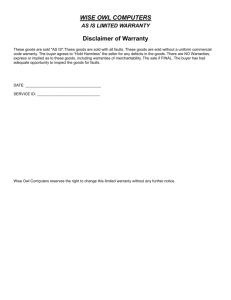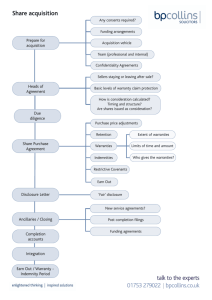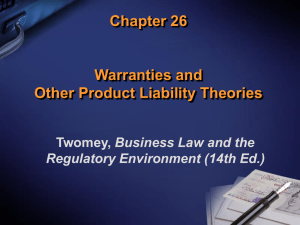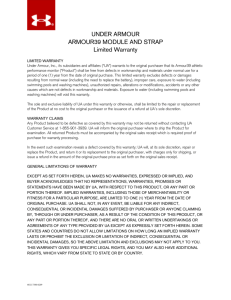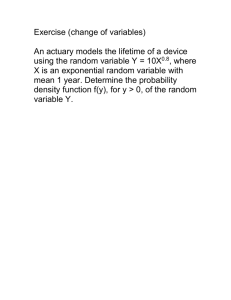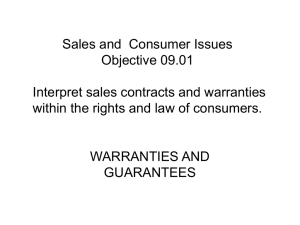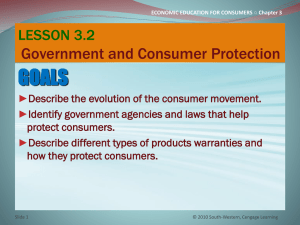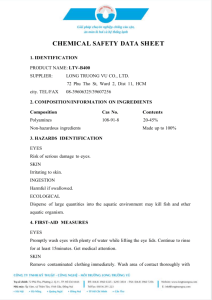Lasting a Lifetime - Miller Thomson LLP
advertisement
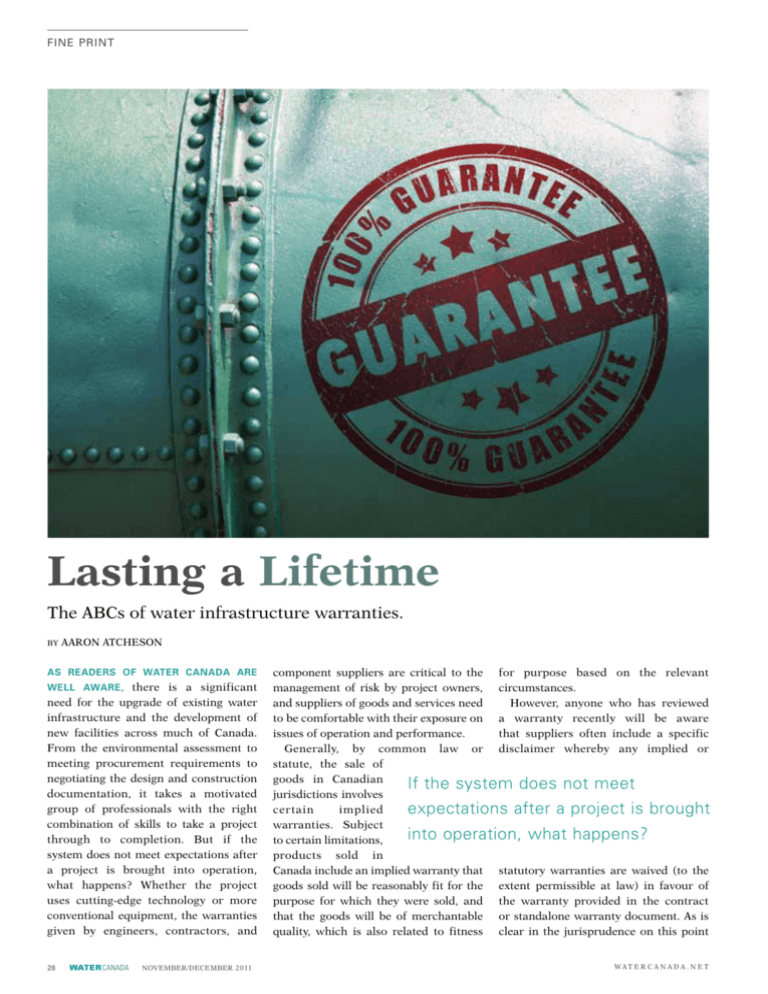
fine print Lasting a Lifetime The ABCs of water infrastructure warranties. By aaron atcheson As readers of Water Canada are well aware, there is a significant need for the upgrade of existing water infrastructure and the development of new facilities across much of Canada. From the environmental assessment to meeting procurement requirements to negotiating the design and construction documentation, it takes a motivated group of professionals with the right combination of skills to take a project through to completion. But if the system does not meet expectations after a project is brought into operation, what happens? Whether the project uses cutting-edge technology or more conventional equipment, the warranties given by engineers, contractors, and 28 WATER CANADA NOVEMBER/DECEMBER 2011 component suppliers are critical to the for purpose based on the relevant management of risk by project owners, circumstances. and suppliers of goods and services need However, anyone who has reviewed to be comfortable with their exposure on a warranty recently will be aware issues of operation and performance. that suppliers often include a specific Generally, by common law or disclaimer whereby any implied or statute, the sale of goods in Canadian If the system does not meet jurisdictions involves certain implied expectations after a project is brought warranties. Subject into operation, what happens? to certain limitations, products sold in Canada include an implied warranty that statutory warranties are waived (to the goods sold will be reasonably fit for the extent permissible at law) in favour of purpose for which they were sold, and the warranty provided in the contract that the goods will be of merchantable or standalone warranty document. As is quality, which is also related to fitness clear in the jurisprudence on this point wat e r ca n a d a . n e t fine print defects unless the seller could not have reasonably discovered the problem (see ABB Inc. v. Domtar Inc. [2007] 3 SCR 461, 2007 SCC 50). At a practical If there is a possibility that the level, this means that all parties need to pay buyer may be selling or otherwise very careful attention to the wording of the transferring the asset during the warranty and the warranty period, this should be related limitations and conditions. And, contemplated in the agreement. depending on the system or equipment and Hunter Engineering Co. v. Syncrude in question, specific performance Canada Ltd., 1989 CanLII 129 (SCC), 35 guarantees may be appropriate. B.C.L.R. (2d) 145), so long as a contract is clear in its intention to limit or Some important issues disclaim implied warranties the courts There is often a cap on the potential will uphold such provisions, especially exposure of the supplier to a percentage in a situation between two commercial of the total contract amount, and a term parties. The situation is somewhat providing that neither party will be liable different under Quebec civil law where, for indirect, consequential, or punitive even with such a disclaimer, a seller is damages. While the latter is expected in presumed to have knowledge of latent most cases, the cap on liability needs to (see, for example, Kobelt Manufacturing Co. Ltd. v. Pacific Rim Engineered Products (1987) Ltd., 2011 BCSC 224, • wat e r ca n a d a . n e t fit with the circumstances; if this contract is for a critical component or service with a modest price, any cap needs to reflect both the potential liabilities of the buyer and the risk the supplier is willing to accept at the agreed price. Buyers should be aware that warranties can be prorated, meaning that the amount that may be claimed falls over time, even though it may be within the warranty period. •Warranties often require written notice of a fault in the equipment within a period of time after the problem is discovered, meaning that a buyer’s staff must be aware of this requirement. Similarly, use of a product outside of dictated operating conditions (for example, within a certain pH range) may be beyond the coverage of the warranty on the basis that the equipment was not intended to work as efficiently (or at all) outside these parameters. So long as the operating conditions fit project realities, and system operators are aware of them, these restrictions are manageable. WATER CANADA NOVEMBER/DECEMBER 2011 29 fine print A misstep in the description of the level of guaranteed effectiveness, or in the formula that establishes the compensation for less-than-intended performance, can result in unintended consequences. consider whether performance warranties based on the degree of effectiveness of the systems installed will be required. On certain projects, especially those using new technologies, these clauses can be the most hotly contested in an agreement and the negotiations will require that the legal professionals work closely with those understanding the requirements of the technology. A misstep in the description of the level of guaranteed effectiveness, or in the formula that establishes the compensation for lessthan-intended performance, can result in unintended consequences. The compensation provided is generally described as a “liquidated damage,” meaning that the ability of the owner to pursue the provider for losses in addition to these amounts is limited, in return for a level of certainty that a damages amount will be paid without a dispute over causation. It is important that the amount of the liquidated damages owing in any particular scenario be appropriate in the circumstances. •All •The agreement may require removal •The parties need to decide whether the of the equipment and return to the seller for testing and repair, something that may not be appropriate in certain situations. The testing procedures, as well as responsibility for the cost of retests, should be discussed. •The definition of the warranty period itself needs to be discussed. The warranty period can commence on delivery to the construction site, or the earlier of incorporation into the system/substantial completion and a certain number of days after being shipped. The parties need to be comfortable with how these provisions fit with the realities of the project. •Some providers require compensation for unnecessary testing where the problem in the system was not their responsibility, a term that should lead buyers to rule out other causes of the fault before claiming under the warranty. 30 WATER CANADA NOVEMBER/DECEMBER 2011 contractor or engineering, procurement and construction (EPC) provider will provide a general warranty over all of the work done and products procured under the contract, or if the buyer is to deal directly with the component suppliers should there be a failure of a particular component. In certain circumstances, a general warranty will only be available if the contracting party is involved in the on-going maintenance of the facility. •If there is a possibility that the buyer may be selling or otherwise transferring the asset during the warranty period, this should be contemplated in the agreement. If assignment requires prior written consent, this must be taken into consideration in planning the closing of a sale transaction. •When dealing with the construction or EPC contract, the parties need to parties need to be comfortable that they are dealing with appropriate entities, with the ability to meet their commitments. If a single-purpose entity is the named party on the contract, it may be appropriate to obtain a parent guarantee or a degree of payment security. With new technologies being incorporated into many water and wastewater treatment projects, some of which have a limited number of commercial-scale precedents, warranties and the strength of the covenant standing behind them have become increasingly important. It is crucial that the various service providers and buyer personnel work together to ensure that the warranties are written in such a way so as to reflect the requirements of the facility and the risk each party is willing to accept. Make sure you have the appropriate professionals on your team. WC Aaron Atcheson is a partner in the London, Ontario office of Miller Thomson LLP and chair of its national cleantech group. He practises in the area of business transactions and energy projects law. wat e r ca n a d a . n e t
